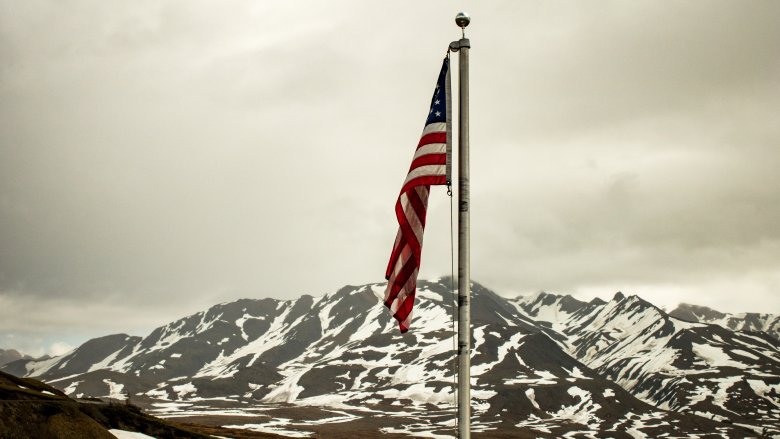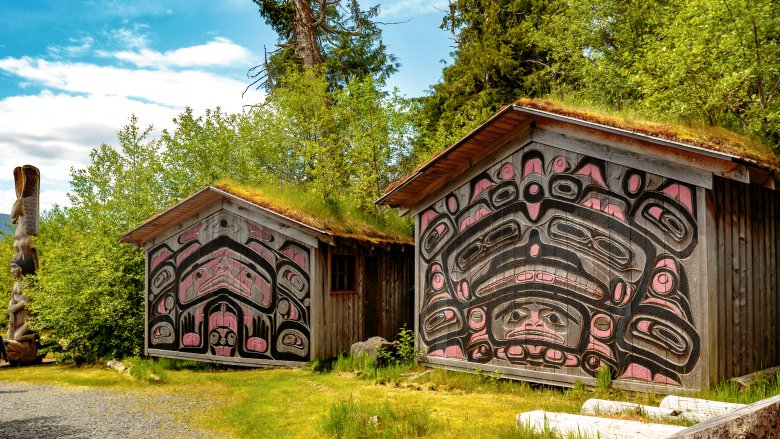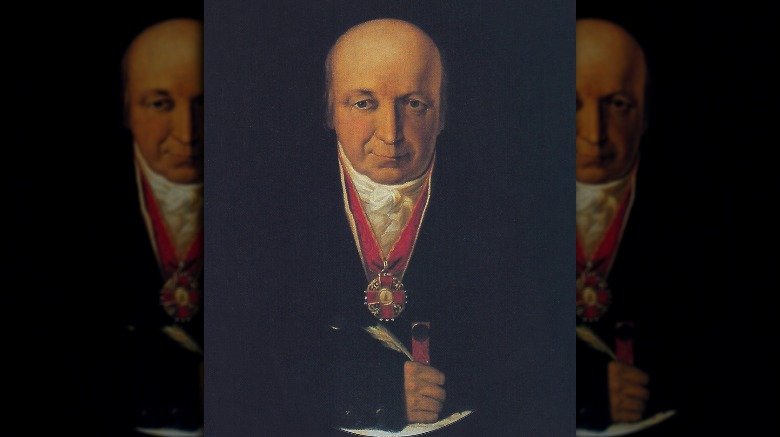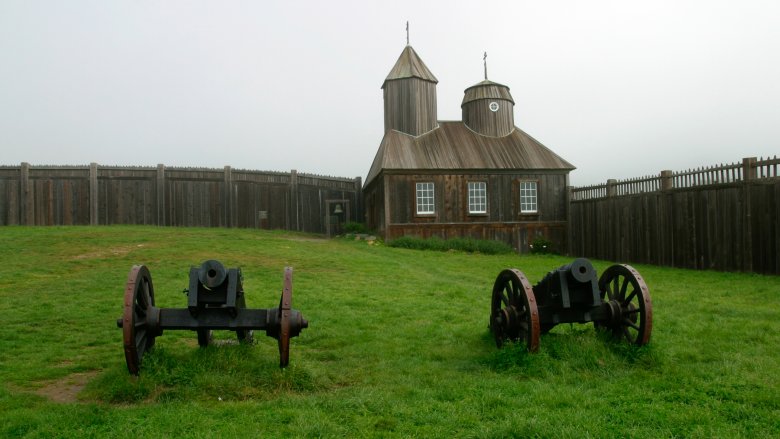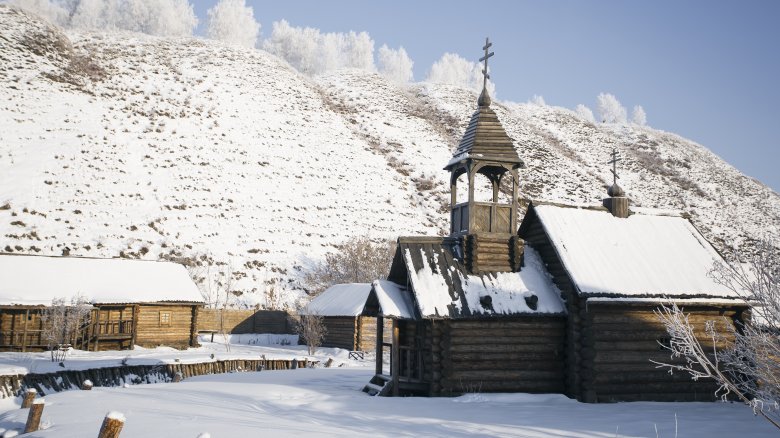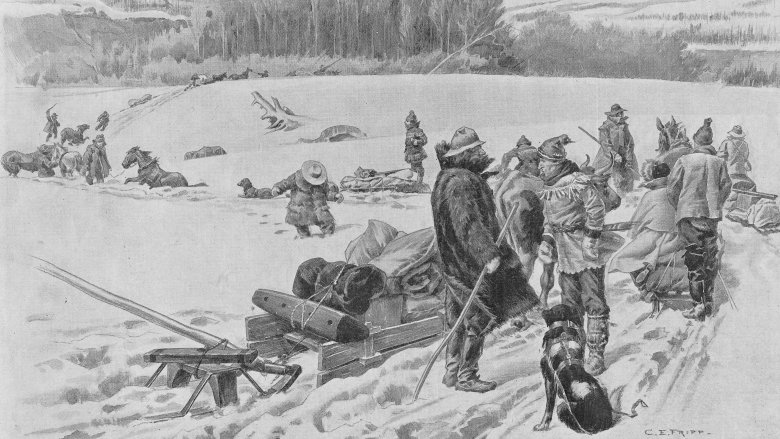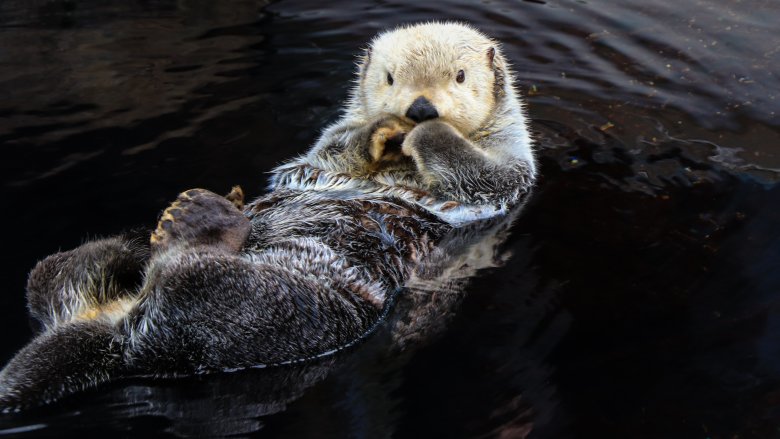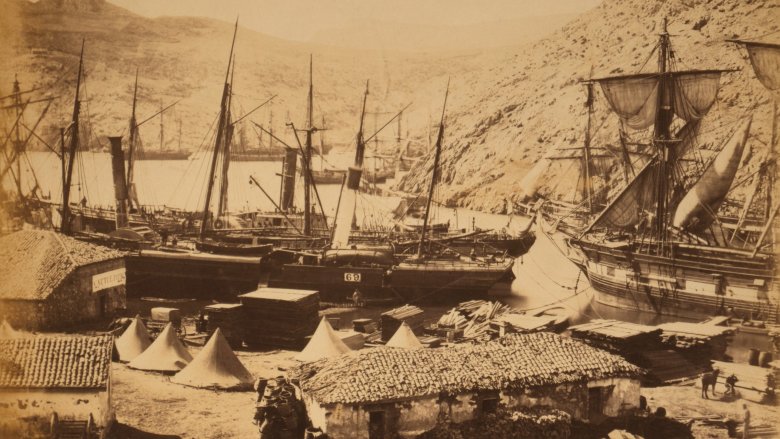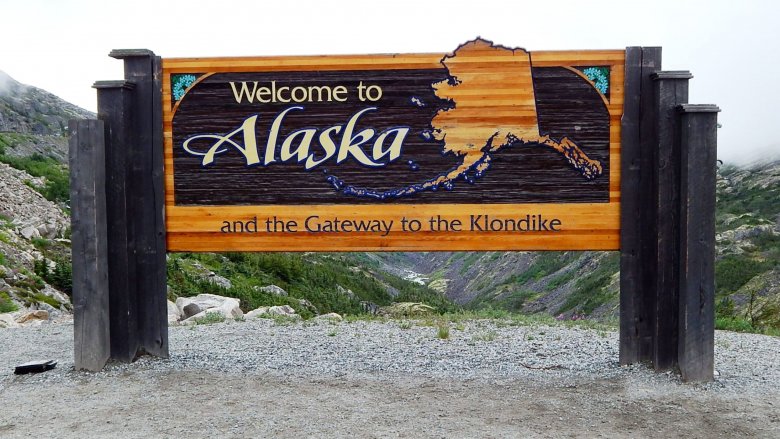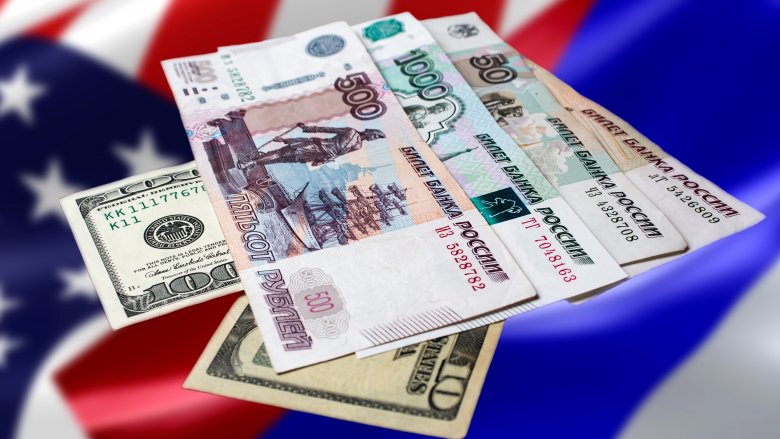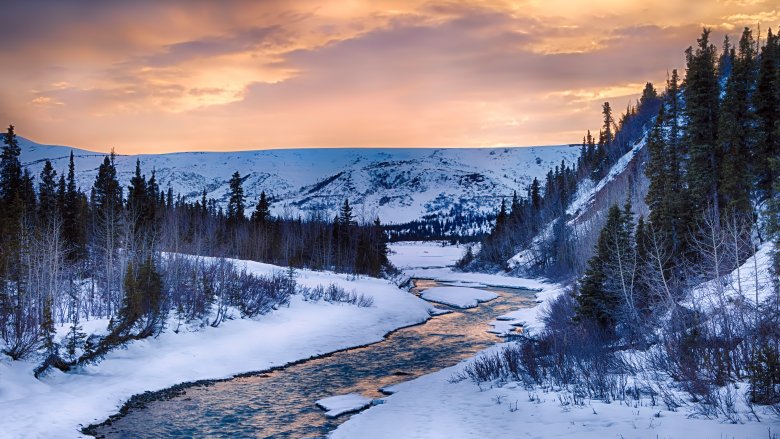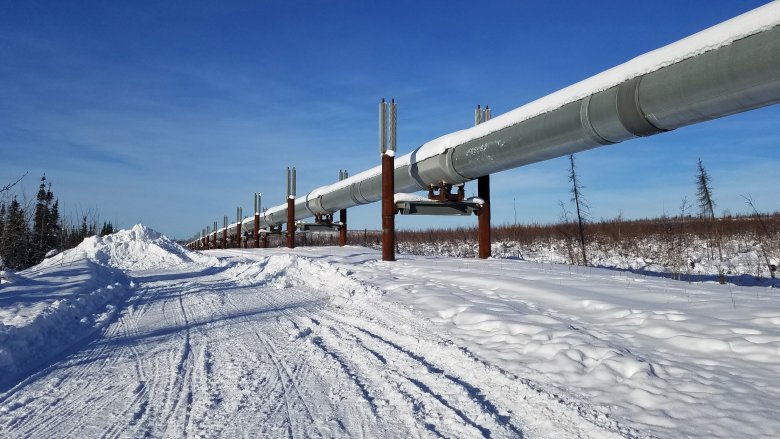The Real Reason Russia Sold Alaska To The United States
We're probably not going to buy Greenland. Sorry, folks. But not long ago, the United States set its sights on another Arctic territory, and today it's the proud owner of the Land of the Midnight Sun, a state rich in oil, fish, minerals, natural wonders, and snow.
Nowadays it would be pretty hard to imagine the 49 United States, or the Canadian province of Alaska, but back in the mid-1800s not everyone thought it was such a great idea to bring those frozen northern lands into the fold. "Why does America need this 'ice box' and 50,000 wild Eskimos who drink fish oil for breakfast?" asked the American press, because the American press in 1867 had no foresight and was also super racist.
Happily, U.S. Secretary of State William Seward didn't listen to the press and went ahead and made the purchase anyway, and now pretty much no one looks back on the sale with regret. Except the Russians. So why did the Russians sell Alaska? Well, it seemed like a good idea at the time.
The Russians weren't exactly welcomed by the indigenous Alaskan people
When the Russians first arrived in the Alaskan wilderness, the indigenous people were all, "Who are you and will you get yourselves and your stupid furry hats off our lands please?" And the Russians were all, "No," and everything kind of went downhill from there.
According to Smithsonian, the Russia/Alaska saga began in 1581, when Russia annexed a Siberian territory from one of Genghis Khan's grandsons and then marched across the land, hunting fur and converting the "heathens" to Russian Orthodox Christianity. By the early 1700s, they were looking beyond Siberia across the Bering Strait (named for Vitus Bering, the Russian who first crossed it in 1741). The second of two expeditions led by Bering was shipwrecked, but the crew repaired the vessel and brought home hundreds of fur seal, sea otter, and fox pelts, which was basically an open invitation for fur hunters to go to Alaska and start angering the natives.
In 1799, the Russians traded a bunch of beads and other crap to the Tlingit people in exchange for a piece of land. The Tlingits later found out the deal included free Tlingit labor and allegiance to the Russian tsar, and by 1802, they were sufficiently pissed off. They attacked a Russian outpost, and in 1804 the Russians countered by bombing them into submission. The 1804 battle was the last major conflict between the Russians and native Alaskans, but those old animosities never went away.
The guys who ran the Russian-American company sucked at it
Alexander Baranov settled in Alaska in 1790 and called himself the "Russian Pizarro." He had an ego, but he wasn't a bad guy — according to Russia Beyond, he built schools, taught the indigenous people how to grow rutabaga and potatoes, and married the daughter of an Aleut chief. As the guy in charge of the Russian-American Company, Baranov also brought industry to Alaska — he built factories, fortresses, and shipyards, and he expanded the already brisk trade in sea otter pelts. While he was in charge, the Russian-American Company was turning a nearly 1000 percent profit, so suck on that Amazon.com.
Things were going pretty awesomely for Russia until Baranov got old and decided to retire. He was replaced by Russian military officers, who decided to give themselves handsome raises. How handsome? Well, the average Russian officer earned 1,500 rubles per year, and the new leader of the Russian-American Company earned 150,000 rubles per year, so yeah. They also decided to stiff the locals by cutting the price of fur in half, which had the end result of killing the whole fur industry. The new officers tried to save the business by adding new sources of revenue like tea and ice, but they stank just as much at managing that line of business, refused to take pay cuts, and basically ended up bankrupting the company.
The Russian farming outpost in California was an abysmal failure
Farming wasn't exactly an industry in 19th century Alaska — the Russians relied on indigenous labor and the indigenous people lacked farming traditions and an understanding of how to raise crops and animals. Also, it's just hard to grow things in Alaska, you know, in general. So the Russians decided to send some people south.
According to FortRoss.org, in 1811 a party led by Ivan Alexandrovich Kuskov set up an outpost named Fort Ross on the California coast just north of Bodega Bay. The idea was to produce grain, beef, and dairy products in the warmer climate and then ship it back to the settlers in Alaska. But the yield was disappointing — mostly because the settlers didn't understand basic farming concepts like crop rotation (maybe because they were mostly native Alaskans who still lacked the same farming traditions they'd lacked back in their homeland?) Anyway, it wasn't just farming that didn't go well for the settlers of Fort Ross, they also stank at shipbuilding. Oh and also, they'd depleted pretty much all of the sea otter in the area by the mid-1830s, which is something they were actually good at. They were mostly okay at raising livestock, too, but it wasn't enough — by 1839 the Russian-American Company decided the venture wasn't worth the investment, and they called all the settlers back to Alaska.
It was too hard to live in Alaska
It's one thing to say to your people, "Go west, where there's good farmland and abundant natural resources, and also great sunbathing and beach volleyball." It's quite another to say, "Go east, where it's freezing fricking cold and you probably won't ever eat a salad again." Alaska is beautiful and abundant but it's not an easy place to live, and it's especially not an easy place to live in the absence of central heating and 64 channels of cable TV for those long, snowed-in winter nights.
According to The Conversation, Russian settlers in Alaska were thousands of miles away from the motherland, and life was hard. So despite the fact that Russia was in possession of this huge piece of land, there were never more than 800 settlers living there at any given time. Still, that was 800 people that were unable to provide for all of their own basic needs, so it was up to Russia to somehow support and keep them happy, and it's tough to keep people happy when they don't have any salad or beach volleyball.
The sparsely-populated colonies also presented a logistical problem — how do you defend a territory as large as Alaska when there are only 800 people living there? It was pretty clear early on that Alaska was vulnerable, and Russia really wasn't equipped to protect it.
The Russians feared an Alaskan gold rush. That's right, "feared."
So if you were a colonist in a vast, untamed wilderness and you found out someone discovered gold in your neighborhood, you'd probably think to yourself, "Cool, gold. I'm gonna be rich." Or would you? Now imagine being a colonist who finds out gold was just discovered in your neighborhood, and imagine standing on your back porch and watching while a ginormous crowd of people with pickaxes and shovels come storming through your garden fence hoping to get a piece of the golden pie.
According to the New York Times, fear that a gold rush might overwhelm the few Russian settlers who were eking out an existence in the Alaskan Bush ended up being one of the driving forces behind the tsar's decision to sell the territory to the United States. Was it a smart decision? Well, there was an actual gold rush just a couple of decades later, and at that point, a lot of Russians did lament the sale of Alaska (who are we kidding, a lot of Russians are still lamenting the sale of Alaska). But it probably would have gone down a lot like the tsar was afraid it would, so whether it was a good idea will be eternally up for debate.
They pretty much drove their own fur industry to extinction
After the grossly overpaid Russian military officers took over the Russian-American company, the fur trade became one of the earliest casualties of their stupid business decisions. The decision to pay only half what they'd once paid for pelts wasn't just stupid in the sense that it angered the local people who had grown to depend on the fur trade for survival, it was also stupid in the sense that it encouraged the locals to double down on hunting and trapping so they could continue to earn enough money to survive.
Today we all know that overhunting is a terrible idea, and in the 19th century, well, they probably knew it was a terrible idea then, too, they just didn't care. So Russia Beyond says that eventually the Eskimo and Aleut hunters had killed all the adult otters and there weren't enough young otters to replace them, and that was pretty much the end of the Alaskan fur industry, so good job everyone.
After the death of the fur industry, Alaska started to look a whole lot less appealing to the people on the other side of the Bering Strait. Without that essential piece of revenue from the Alaskan territories, it became a lot harder for the tsar to justify hanging onto the suddenly much-less profitable Alaskan territory.
Alaska was too hard to defend
Russia had problems internationally, too, and it got especially bad in the 1850s when Russia clashed with France, Turkey, and Britain in the Crimean War, which was really about religious differences and control of access to religious places in the Holy Land. What exactly did that have to do with Alaska? Well, during the conflict, the opposition controlled all of the sea routes, and the Russians were very rightly afraid that they would be cut off completely from their North American territory.
According to History, the Crimean War raged for three years and by the end of it, Russia had lost 500,000 troops and its economy was in ruins. It began to fear that its possession of Alaska made it vulnerable — it was clearly unable to afford to send supplies to the colonists anymore, and it wouldn't be able to defend them against an attack, either. Russia needed a military presence along the Pacific coast, but given the state of things after the Crimean War, it just wasn't something they could afford to do. And Britain and the Unites States were already showing signs of infringing on Russian territory — their whaling ships frequented the waters controlled by the Russian-American Company, creating a unique new problem. Parting with Alaska was starting to sound like a pretty good idea.
So why didn't they just sell Alaska to Canada?
It seems it like it would make a certain amount of logical sense to sell your unwanted piece of property to the people who own the land adjacent to your unwanted piece of property. In the case of Alaska, that adjacent border stretched 1,538 miles, so it kind of seems like a no-brainer. Unfortunately, though, it wasn't that simple — it's not like Russia could just go round to Justin Trudeau's house and strike up a deal over poutine and a Yukon Jack. No, because at the time, there was no Justin Trudeau and Canada wasn't even Canada.
According to How Stuff Works, during the late 1850s, when Russia seriously began to ponder this idea, Canada was basically still Britain. And you already know how Russia felt about Britain so soon after Britain kicked its fur-clad butt during the Crimean War.
There were regrets, though. The sale of Alaska to the United States included an area called the Alaska Panhandle, which was a narrow coastal region rich in fish with no established border. Four years after the purchase, Canada was all, "Hey, we need to know where that border is," and America was all "No, that would cost too much," and then the Klondike gold rush happened and Canada was all, "Hey, we really need to know where that border is." And then it degraded into an argument about the definition of "coastline." The dispute was eventually settled by a tribunal.
It seemed like a good idea at the time
On the other hand, during the 1850s, just after the Crimean War, Russia was actually pretty friendly with the United States. That's kind of hard to believe, right? Well, it wasn't because the two governments were especially chummy or anything, it was because American newspapers mostly came out in support of Russia during the Crimean War. America even sent weapons and supplies to Russian troops, so Russia figured that America, in general, was probably going to be friendlier to the Russian cause than it was to Britain's cause. After all, Britain had suffered two defeats at the hands of America in the past century, and some of those old animosities still lingered. And the fact that Britain was still doing the whole imperialism thing was another strike against it — both Russia and America saw British imperialism as a not-very-good-thing to have on the world stage.
So as far as potential allies were concerned, Britain was pretty much out, and America was maybe kind of sort of in. So the decision to sell Alaska to America was as much a strategic one as it was a financial one. Also, it was fun for the Russians to mess with the Brits. "From the Russian point of view, the deal made a lot of sense," historian Susan Smith-Peter told the New York Times. "They could irritate Britain, and they could have a closer relationship with the United States."
So why did America want freeze-your-butt-off Alaska anyway
If Alaska was bad for the Russians, why on Earth did the USA imagine that it would be good for the Americans? All the same problems remained regardless of whose hands the territory was in. Like Russia, America didn't share a border with Alaska. There was still no fur trade, there was still no agriculture, and it was still miserably cold.
Well, according to The Conversation, America was in the midst of a land grab (it wasn't imperialism if the Americans did it) — it had just annexed Texas, won California in a war, and was in hot pursuit of Oregon. Secretary of State William H. Seward believed that America was "destined to roll resistless waves to the ice barriers of the north, and to encounter oriental civilization on the shores of the Pacific." Oh no, that sounds nothing like imperialism. Anyway. America also had plans for the fisheries and thought there might be gold up there. Mostly, though, it was America's dumb idea of "manifest destiny" that drove the decision — they were going to buy Alaska because white America ruled and everyone else drooled. So in the end they struck a deal, and it was a damned fine one even by today's standards. On March 30, 1867, Seward and Russian envoy Baron Edouard de Stoeckl signed the Treaty of Cession, which gave the entire Alaskan territory over to the United States for $7.2 million, or roughly 2 cents an acre.
It actually panned out quite well for America
Even so, people were all, "Why did we buy that no-fur-trade, no-agriculture, freeze-your-butt-off place, anyway?" Even at 2 cents an acre, they really couldn't see any point. It seemed sort of like buying the moon for 2 cents an acre — sure it's a bargain, but what are you going to do with it, really?
According to Smithsonian, critics of the purchase called it "Seward's Folly," or less flatteringly, "Walrussia." And for a while it sort of seemed like the naysayers might have been right — for decades, the territory sat mostly ignored. But Seward received his vindication 50 years after the purchase when the Klondike gold rush sent 100,000 settlers to Alaska and brought $1 billion to the American economy. Meanwhile, Russia's collective "damn it" was heard 'round the world.
Today, Alaska is one of the richest states in America, with prosperous fishing and tourism industries and an even more prosperous petroleum industry — since 1967, more than 16 billion barrels of oil have been pulled out of Prudhoe Bay. Just think, Russia, all that could have been yours. Ironically, Alaska was also in a pretty strategic location when the USSR and the United States eventually did become enemies during the Cold War. So overall, it kinda worked out. Sorry, Russia.
We were just kidding about the whole selling Alaska thing
20/20 hindsight is a pretty brilliant thing, isn't it? Even today, there are people in Russia who are still grumbling about the huge mistake that Tsar Alexander II made when he signed away the entire Alaskan territory for 2 cents an acre. In 2014, the Moscow Times wrote that there was a growing amount of "generally facetious" talk about taking back Alaska, which seemed to become a little bolder after the Russians annexed Crimea in order to correct a "historical mistake."
Yes, the butt-hurtedness still reverberates 150 years after the sale was completed. "Along with Alaska, you sold out your Russian people," Vladimir Kolychev whined in a poem addressed to the dead tsar. Sergey Aksyonov, the prime minister of Crimea was less sentimental. "If Russia was in possession of Alaska today, the geopolitical situation in the world would have been different," he said. And he's right — if Russia still owned Alaska, they'd be the ones controlling all of the oil, mining, fisheries, and the state's other riches. And America would have no strategically-placed military bases at the top of North America, and no claim to the Arctic at all, which means no real voice when it comes to addressing climate change-related problems like melting glaciers. But hey, that's not how it worked out, Russia. This is one freeze-your-butt-off-cold war you definitely can't win.
